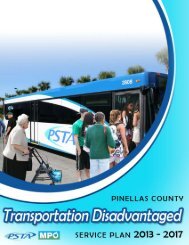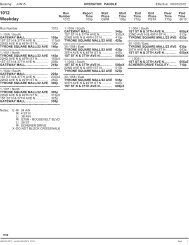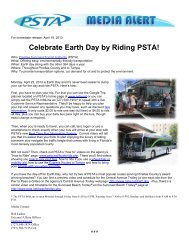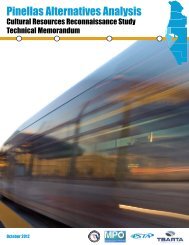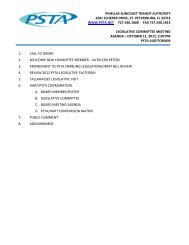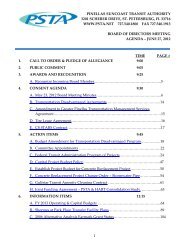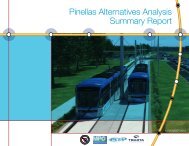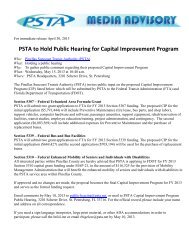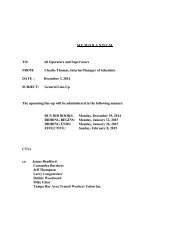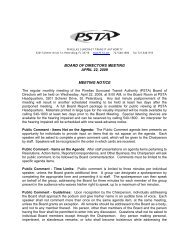DRAFT
FY 2020 - PSTA
FY 2020 - PSTA
- No tags were found...
Create successful ePaper yourself
Turn your PDF publications into a flip-book with our unique Google optimized e-Paper software.
Improve the project delivery process by eliminating duplication in documentation and procedures;Facilitate private investment in the national transportation system that furthers the public interest;Ensure that States receive a fair rate of return on their contributions to the Trust Fund;Provide transportation choices; andImprove the sustainability and livability of communities.Clean Air Act of 1990The Clean Air Act of 1990 and subsequent amendments determine the National Ambient Air QualityStandards (NAAQS). NAAQS are standards based on the amount of particulate matter in the air, measuredin parts per million for the following pollutants:Carbon Monoxide (CO);Nitrogen Dioxide (NO2);Ozone (O3);Sulfur Dioxide (SO2);Lead (Pb); andParticulate Matter (PM).On January 6, 2010, EPA proposed revisions to the National Ambient Air Quality Standards (NAAQS) forground-level ozone. The standards are based on scientific evidence about ozone and its effects on people,sensitive trees, and plants. The proposed revisions would affect two types of ozone standards. The firststandard affected deals with protection of public health, including the health of at-risk populations such aschildren, people with asthma, and older adults. The secondary standard affected by revisions deals withprotection of public welfare and the environment, including sensitive vegetation and ecosystems.Specifically, the EPA proposes to revise the existing ozone standards and update the Air Quality Index(AQI) for ozone.An area meeting NAAQS standards is classified as an “attainment area.” According to the previous AirQuality Technical Report in 2004, Pinellas County falls in this category as an “attainment/maintenance”area for all NAAQS pollutants. However, the stricter standards resulting from the implementation ofNAAQS revisions will cause a greater amount of locations to be classified as “non-attainment areas.” Inorder to receive transportation funding, Pinellas County must meet Federal ozone standards. EPA plans toissue final standards by October 31, 2010. At that time, Pinellas County may need to increase ozonereductionefforts. The implications of this act are increasingly higher capital and infrastructure costs fortransit vehicles and equipment to meet increasingly stringent air quality regulations.Tindale-Oliver & Associates, Inc.Pinellas Suncoast Transit AuthoritySeptember 2010 2-2 Transit Development Plan




